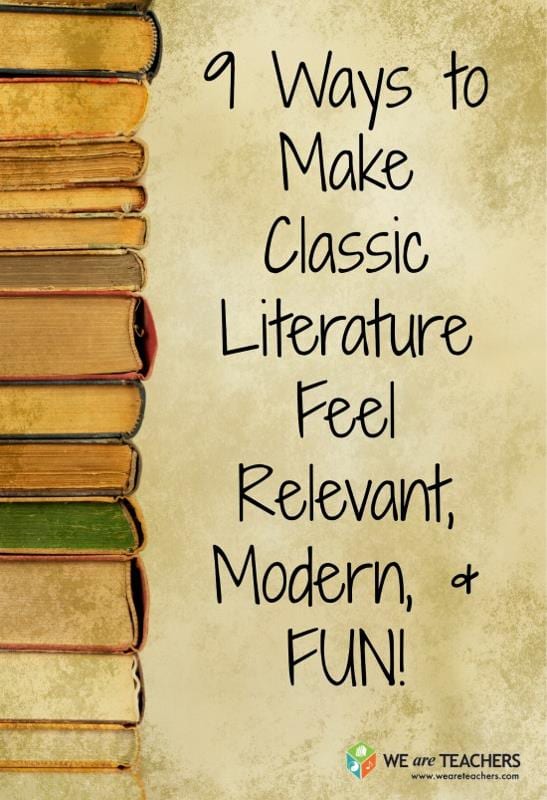“But this book is so old!” Sound familiar? Never fear! Here are some foolproof ways to keep the classics fresh for the modern-day student.
1. Pair contemporary poetry and short stories with the classics. Invite students to read modern short stories and poetry and make thematic connections to a classic you are reading in class. Ask students to compare and contrast these supplemental pieces with their main text—what views do they share regarding central topics and themes? How are they different? Poets.org is an excellent resource for this, as you can search for poems by topic.
Examples of connective texts:
- 1984, George Orwell – “The Censors,” short story by Luisa Valenzuela.
- Romeo and Juliet, William Shakespeare – “Blood,” poem by Naomi Shihab Nye.
- The Great Gatsby, F. Scott Fitzgerald – “Otherwise,” poem by Jane Kenyon.
- The Awakening, Kate Chopin – “In the Dark We Crush,” poem by Julia Cohen.
- Hamlet, Shakespeare – “A Primer for the Punctuation of Heart Disease,” short story by Jonathan Safran Foer.
2. Get social. Have students choose a character from the classic they’re reading and create a Twitter account (on paper!) for that character. They then create an original Twitter handle, like @TheRealWanderlust for Odysseus or @IndependentWoman for Jane Eyre, and write 6 to 10 tweets that carry throughout the arc of the story. Create different rules, like they have to tweet at two other characters or need three original hashtags throughout their tweets. Have fun with it!
3. Make personal connections. Sometimes students can get so bogged down in the older settings, antiquated language and complicated plot details of the story that they forget there are transcendent themes in these classics. Before reading, ask students some questions the book examines. The students give their personal responses, and after reading, they compare their responses to the book’s answers to those questions. This is often called an anticipation guide, and it highlights the real-world connections the books offers.
Examples of essential questions:
- The Awakening: Is it ever moral to cheat on one’s spouse? How far would you go to keep your identity?
- The Great Gatsby: Can one truly reinvent oneself? Is it possible to leave the past behind?
4. Recast the classics. This activity emphasizes how culturally specific stories can still be universal by “recasting” the book into the modern day. First, students identify cultural specifics from the story (like setting, time period or religion) versus large, universal ideas (such as family conflict or the desire for independence). Then, the students recast the details into a modern setting. Here’s an example of some guiding questions from Hermann Hesse’s Siddhartha that could be adapted for your book to help students with their recasting.
- Instead of being a Brahmin priest, who is the father of Siddhartha? Remember that he would have to be a very high-profile, powerful member of society.
- Instead of a Hindu society, what society is your “recast Siddhartha” part of?
- Why might the “recast Siddhartha” want to escape that society? Why is it unfulfilling for him/her?
- Hesse’s Siddhartha leaves his opulent lifestyle to join the ascetics, a group of people that leads an extremely simple lifestyle and rejects life’s normal pleasures and material satisfaction. What group does the “recast Siddhartha” join upon leaving his/her own society?
5. Host a Socratic seminar. Shake up the boring back-and-forth Q-and-A tennis match with a student-led Socratic seminar. Instead of having students complete questions on their own, have them read the chapter at home and take notes. In class, students sit in a circle, then receive the questions and discuss them, referring to the text and their notes. Have one person record the group’s answers—this will require appropriate pacing and a healthy group discussion to arrive at a consensus. Having the students complete the questions as a group as opposed to individually allows teens to consider multiple perspectives in addition to their own. Print out a class roster and note the quality and quantity of each class member’s contributions for a participation grade.
6. Try literature circles. Instead of having all students read the same book, allow them to form small, interest-based groups and choose their own classics! Select the era—Renaissance, Reconstruction, what have you—and allow students library time to browse and choose a title that appeals to them. In their small groups, they can create reading goals and ideas for structuring their discussions. Your full-class lessons would focus on reading strategies and supplemental materials from the era, such as a complementary poem that the class discusses before breaking into book groups and applying it to their own book.
7. Analyze just a short passage. Often students get bogged down by the sheer length of classic novels and works of literature. So keep things smaller—try projecting the richest passage (one or two paragraphs) from their latest chapter on your board. If you don’t have projection technology, run off a handout of the passage so everyone has a copy. Read the passage, and then conduct a full class analysis by: 1) identifying where the passage appears in the chapter, 2) summarizing what is being said (comprehension) and 3) analyzing the text by identifying different literary techniques and examining their effects.
For example, if there are many words with negative connotations, what effect does that have on the tone of the passage? What kinds of metaphors and similes are being used, and what does this figurative language communicate to the reader beyond the literal? In this way, you will be using the classics to teach skills that will work for all types of reading and media. Once you have done this a few times as a class, try breaking up students into small groups and letting them try it on their own. Eventually, they will be strong enough to do it independently!
8. Borrow classic techniques for students’ own writing. This works especially well for satire, like Mark Twain’s The Adventures of Huckleberry Finn or Jonathan Swift’s “A Modest Proposal.” As you read with students, identify not just what but how the author satirizes. After identifying the technique, students apply it by creating their own satires. For example, in Huckleberry Finn, Twain establishes the character of Pap as an untrustworthy “bad guy” with his drunkenness and his physical abuse of Huck. Therefore, when Pap launches into his racist tirade in chapter six, the reader is forced to question these hateful attitudes. Because they come from Pap, Twain shows that racism is wrong. Students can apply this technique—communicating a view through an unreliable voice—to an issue they personally care about, be it a school policy, community issue or something more global.
9. Teach your favorites. No teaching strategy is more effective than simply sharing your passion. It’s contagious! Sharing your favorite classic books, authors, passages and lines will help ignite a spark in your students. Post awesome book quotes around your room; talk about your memories of reading these books for the first time. At the end of the day, genuine enthusiasm and a personal endorsement go a long way in keeping the classics fresh!


